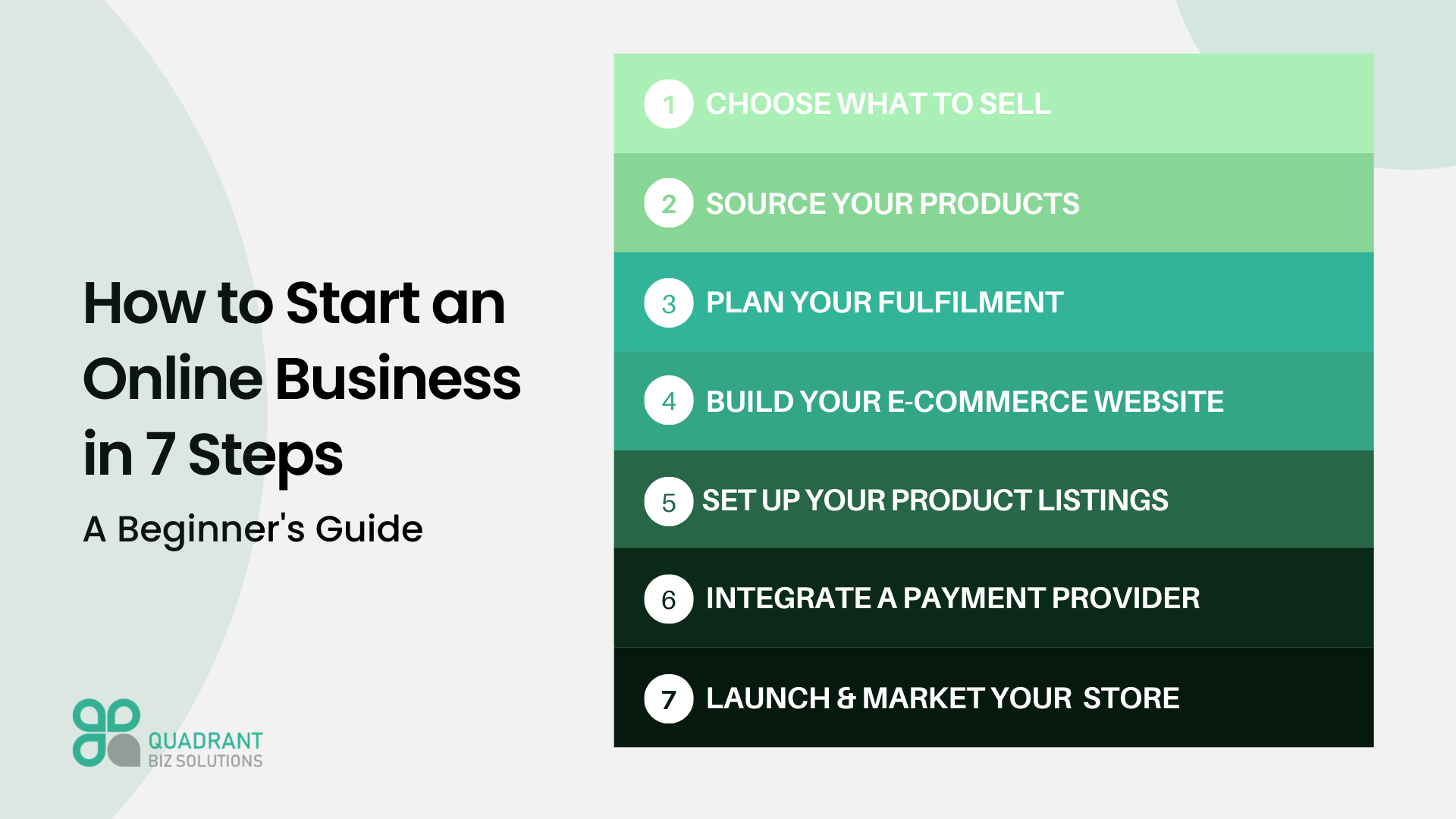Starting an online store in 2025 presents an incredible opportunity for entrepreneurs looking to tap into the growing digital marketplace. With more consumers turning to e-commerce for their shopping needs, the potential for building a successful online business has never been greater. Whether you’re looking to sell physical products, digital goods, or even services, the process of setting up an online store has evolved significantly. The key to success lies not just in having a great product but also in adopting the right strategies, tools, and marketing techniques.
To help you navigate the process, this article will explore the essential steps involved in starting a successful online store in 2025, from selecting a niche to marketing your products and leveraging emerging technologies to enhance customer experiences.
1. Choose Your Niche and Business Model
The first and most important step in starting an online store is choosing your niche. This is where many entrepreneurs often stumble, but it’s crucial to pick a niche that you are passionate about, knowledgeable in, and that has demand in the market. Whether it’s a specific category of products, like eco-friendly home goods, or a broader market, such as fashion or electronics, finding the right niche is the foundation of your business.
There are several business models you can consider for your online store, each with its own advantages. Some of the most popular options include:
- Dropshipping: This business model allows you to sell products without holding any inventory. When a customer places an order, the product is shipped directly from the supplier to the customer. This model requires low startup capital and minimal risk but may have lower profit margins.
- Inventory-Based Store: In this model, you purchase inventory upfront and store it either at your location or through a third-party warehouse. You have more control over your products, but you’ll need more capital to buy the stock and deal with storage and fulfillment.
- Subscription-Based Store: Offering subscription boxes or recurring delivery of products can generate steady, recurring revenue. Subscription-based businesses work well for niche markets such as health and wellness products or gourmet foods.
- Digital Products or Services: With digital products like e-books, online courses, or design templates, you don’t have to worry about physical inventory, and the potential for scalability is enormous.
Once you’ve chosen your niche, it’s important to evaluate market trends. Researching the current business trends in your chosen category can help you understand customer demands and competition. Knowing where the market is heading will allow you to make informed decisions about your offerings and marketing approach.

2. Select the Right E-Commerce Platform
In 2025, there are numerous e-commerce platforms available, and choosing the right one is essential for the success of your online store. The best platform for you will depend on your business model, technical knowledge, and budget.
Some of the top e-commerce platforms to consider include:
- Shopify: One of the most popular e-commerce platforms, Shopify is known for its user-friendly interface, scalability, and customizable themes. It offers a variety of built-in features for payment processing, inventory management, and marketing.
- WooCommerce: If you already have a WordPress site, WooCommerce is an excellent choice. It’s a free plugin that turns your WordPress site into a fully functional online store. It’s customizable and ideal for entrepreneurs with some technical expertise.
- BigCommerce: This platform is similar to Shopify but offers a more robust set of features out-of-the-box for larger stores. BigCommerce is ideal for those looking to scale quickly.
- Wix: For beginners with little to no technical experience, Wix is an intuitive platform that allows you to drag and drop elements to create your store. It’s best for small-scale stores but lacks some advanced features that other platforms offer.
Each platform has its pros and cons, so you’ll need to consider factors like ease of use, cost, integrations, and scalability when making your choice. Once you’ve selected your platform, you’ll need to set up your store, choose a domain name, and customize your design to reflect your brand.
3. Source Your Products and Manage Inventory
The next step is sourcing products for your online store. If you’re selling physical products, you’ll need to establish relationships with suppliers or manufacturers. If you’re dropshipping, you’ll partner with suppliers who will handle inventory and shipping directly.
You can source products in several ways:
- Wholesale Suppliers: Purchasing products in bulk from a wholesale supplier is a traditional way to source products. This method works best if you have the capital to purchase inventory upfront and want to have control over product quality and shipping.
- Dropshipping Suppliers: If you’re using a dropshipping business model, platforms like Oberlo and Spocket connect you with suppliers who handle inventory and shipping for you. This allows you to sell products without worrying about managing stock.
- Private Labeling: This method involves sourcing generic products and rebranding them with your own logo and packaging. It’s ideal if you want to create a unique brand identity but don’t want to manufacture products from scratch.
- Digital Products: If you’re selling digital products, the process is simpler since you don’t have to worry about sourcing physical inventory. You can create your own digital products or license content from others.
Inventory management is another important aspect of running an online store. Efficiently managing stock levels, tracking orders, and fulfilling customer requests are critical for maintaining customer satisfaction. Many e-commerce platforms offer built-in inventory management features, or you can use third-party apps to streamline this process.
4. Create a Seamless User Experience
A seamless user experience (UX) is crucial to the success of your online store. Your website needs to be visually appealing, easy to navigate, and optimized for mobile devices. According to statistics, more than half of all online traffic comes from mobile devices, so ensuring your store is mobile-friendly is essential.
Some key UX factors to consider:
- Speed: Your website must load quickly to avoid losing potential customers. A slow-loading website can negatively impact conversions, so optimize your images and use caching to improve speed.
- Navigation: Ensure your website is easy to navigate. Categories should be clearly labeled, and customers should be able to find what they’re looking for with minimal effort.
- Checkout Process: The checkout process should be straightforward and simple. Offer multiple payment options and make sure that the process is fast and secure.
- Customer Support: Offering various ways for customers to contact you, such as live chat, email, or phone support, is essential for creating a positive user experience.
An optimized user experience leads to higher conversion rates and customer satisfaction. You can also implement tools like AI-powered chatbots to enhance customer support and personalize the shopping experience.
5. Implement a Strong Digital Marketing Strategy
Once your online store is set up and running, it’s time to focus on attracting customers. In 2025, a strong digital marketing strategy is essential for driving traffic to your site and converting visitors into buyers. There are several marketing tactics you can use to promote your online store:
- SEO (Search Engine Optimization): Optimizing your website for search engines is one of the most effective ways to attract organic traffic. Use relevant keywords, optimize your product descriptions, and focus on building quality backlinks. An effective SEO strategy can help you rank higher on search engine results pages (SERPs), increasing visibility and traffic.
- Social Media Marketing: Platforms like Instagram, Facebook, Pinterest, and TikTok are powerful tools for promoting products and engaging with potential customers. Creating visually appealing content and running targeted ads can help you reach a larger audience and drive traffic to your store.
- Content Marketing: Publishing high-quality blog posts, videos, and guides on your website can help attract visitors and establish your authority in your niche. Offering valuable content can also improve your SEO and drive long-term traffic.
- Paid Advertising: Using paid advertising, such as Google Ads or Facebook Ads, allows you to target specific audiences and generate quick results. Paid campaigns can be highly effective when combined with a strong SEO strategy.
- Email Marketing: Building an email list and sending personalized offers, discounts, and product recommendations can help you nurture relationships with potential customers and drive repeat sales. Consider using email marketing tools like Mailchimp or Klaviyo to automate your campaigns.
6. Analyze and Optimize Performance
Once your online store is up and running, it’s important to regularly monitor and analyze its performance. Tools like Google Analytics and your e-commerce platform’s analytics features can provide valuable insights into customer behavior, conversion rates, and sales trends.
Tracking key metrics such as website traffic, bounce rates, average order value, and customer lifetime value will help you understand what’s working and what needs improvement. Use this data to refine your marketing efforts, optimize your website, and improve customer engagement.
Conclusion
Starting an online store in 2025 is a highly viable business idea, but success requires more than just listing products online. You need to focus on choosing the right niche, selecting an optimal e-commerce platform, sourcing quality products, and creating an excellent user experience. Furthermore, implementing a robust digital marketing strategy and continuously analyzing your performance will ensure that your store grows and remains competitive in an increasingly crowded market.
By leveraging the latest tools, trends, and marketing strategies, you can create a profitable online business that thrives in 2025 and beyond. With careful planning, dedication, and a commitment to providing value to your customers, your online store can become a successful and sustainable venture in the booming e-commerce landscape. To stay updated on the latest business trends and ideas, check out more resources on business trends, and don’t forget to explore startup ideas and small business strategies to help guide your journey.

